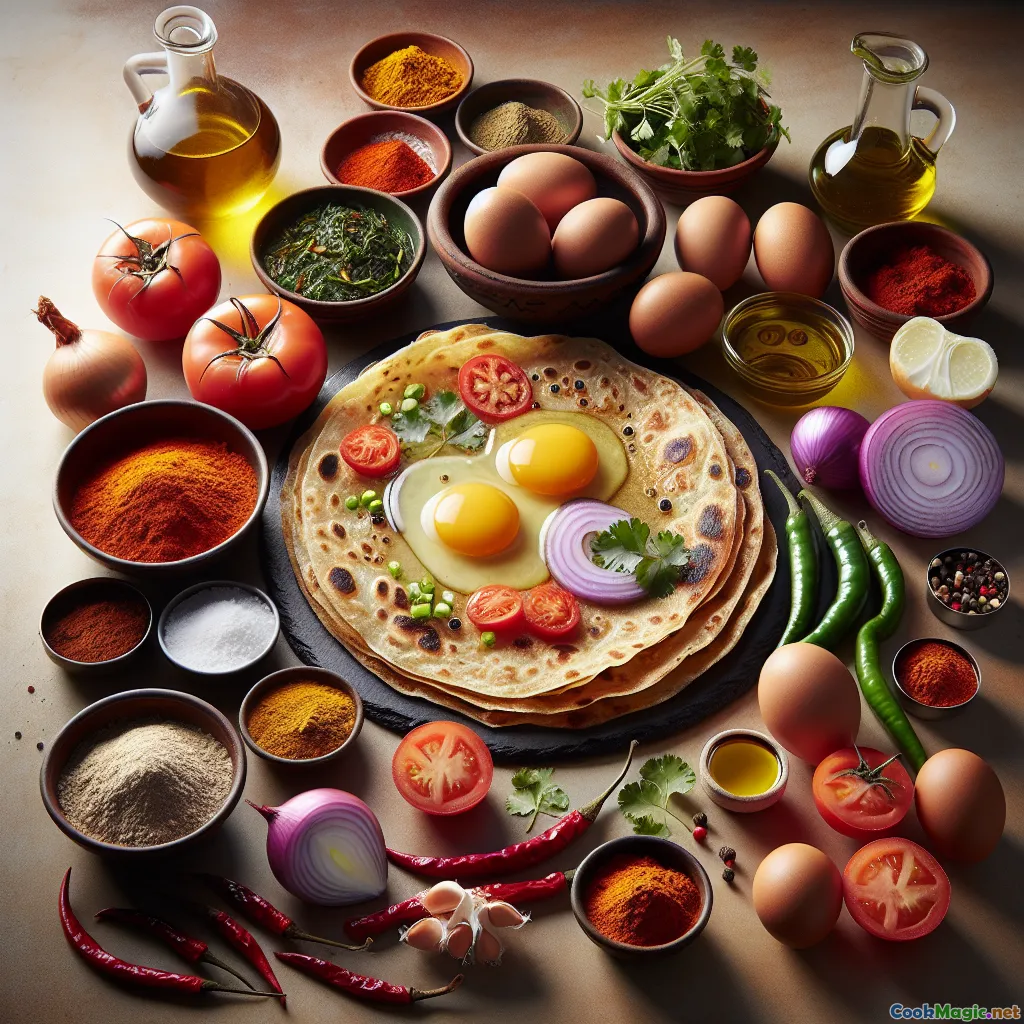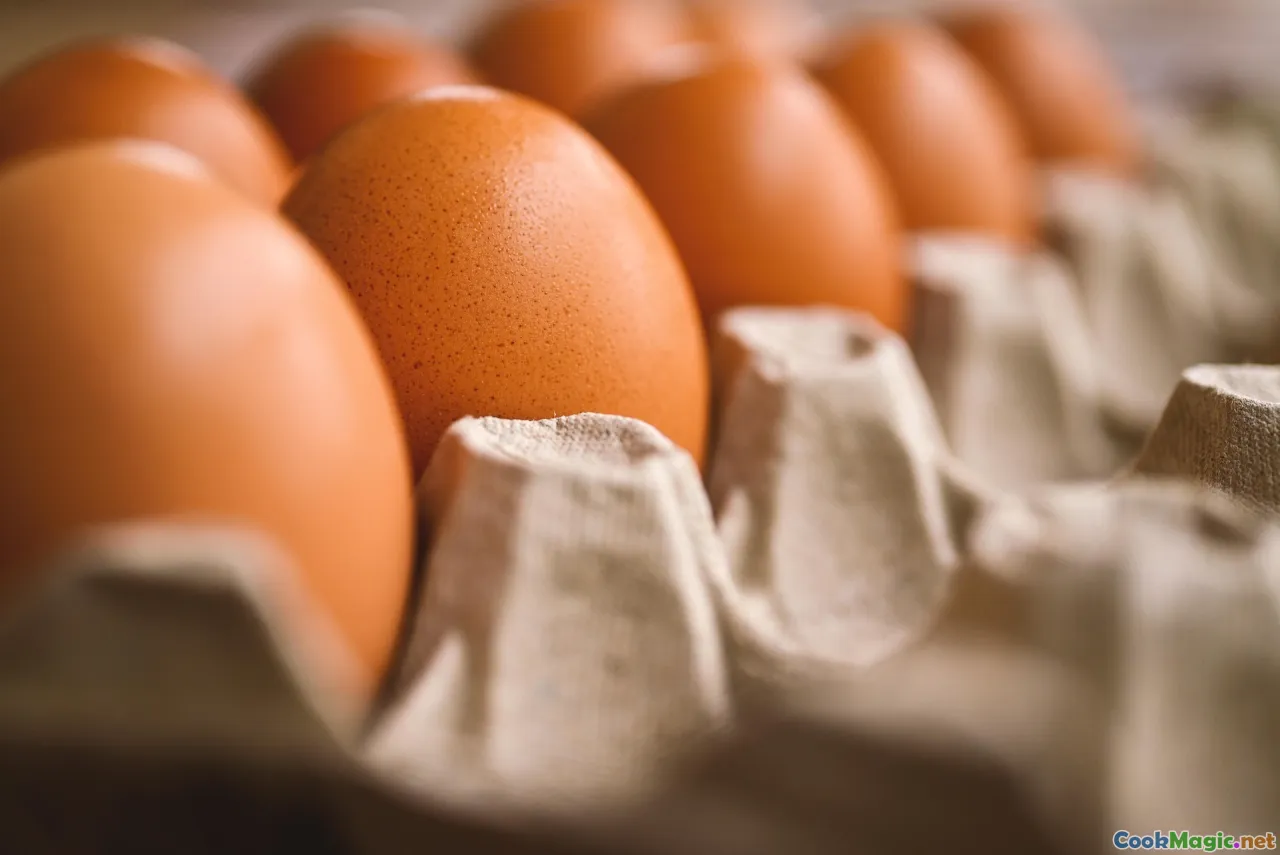
Saltato Piccante di Uova Parotta di Virudhunagar
(Fiery Virudhunagar Egg Parotta Stir-Fry)
(0 Recensioni)0
1,086
luglio 15, 2025
Segnala un problema
Ingredienti
-
3 pieces Parotta (pane piatto sfogliato)
(Preferibilmente fatto in casa o da una panetteria locale)
-
3 large Uova
(Usa ingredienti freschi e allevati all'aperto per il miglior sapore)
-
1 medium Cipolla
(Affettato finemente)
-
1 medium Pomodoro
(Tagliato finemente)
-
2 pieces Peperoncini verdi
(Affettato o tritato (regolare alle spezie))
-
1 teaspoon Pasta di zenzero e aglio
(Macinato fresco preferito)
-
1 teaspoon Polvere di Peperoncino Rosso
(Regola la temperatura desiderata)
-
1/4 teaspoon Polvere di Curcuma
-
1/2 teaspoon Garam masala
-
1/4 teaspoon Pepe nero
(Macinato fresco)
-
2 tablespoons Foglie di coriandolo
( Tritato finemente, per guarnire)
-
2 tablespoons Olio da cucina
(Preferibilmente olio di girasole raffinato)
Sale, to taste
-
2 pieces Spicchi di limone
(Per servire)
(Preferibilmente fatto in casa o da una panetteria locale)
(Usa ingredienti freschi e allevati all'aperto per il miglior sapore)
(Affettato finemente)
(Tagliato finemente)
(Affettato o tritato (regolare alle spezie))
(Macinato fresco preferito)
(Regola la temperatura desiderata)
(Macinato fresco)
( Tritato finemente, per guarnire)
(Preferibilmente olio di girasole raffinato)
(Per servire)
Nutrizione
- Porzioni: 2
- Dimensione Porzione: 1 piatto (250g)
- Calories: 540 kcal
- Carbohydrates: 62 g
- Protein: 17 g
- Fat: 22 g
- Fiber: 5 g
- Sugar: 5 g
- Sodium: 600 mg
- Cholesterol: 215 mg
- Calcium: 105 mg
- Iron: 2.7 mg
Istruzioni
-
1 - Sminuzza la Parotta:
Arrotola e sbriciola le parotta in strisce croccanti di dimensioni bite con le mani. Metti da parte.
-
2 - Saltare gli aromi:
Scalda l'olio in una padella pesante. Aggiungi le cipolle e i peperoni verdi, soffriggi fino a renderli morbidi. Mescola la pasta di zenzero e aglio e friggi fino a quando l'odore crudo svanisce.
-
3 - Cucinare pomodori e spezie:
Aggiungi i pomodori, cuoci fino a ottenere una polpa. Spolvera con chili in polvere, curcuma, garam masala e sale. Cuoci per un minuto.
-
4 - Aggiungi le uova e sbattilo:
Sposta il masala da un lato. Rompi le uova nella padella. Cuoci fino a quando sono a metà cottura, mescolando delicatamente, quindi mescola nella base di masala.
-
5 - Incorporare la Parotta:
Aggiungi la parotta grattugiata al composto di uova e masala. Mescola tutto a fuoco alto in modo che il pane assorba i sapori.
-
6 - Finisci e Serva:
Spolvera con pepe nero e foglie di coriandolo. Controlla il condimento, aggiungi le fette di limone ai lati e servi caldo.
Arrotola e sbriciola le parotta in strisce croccanti di dimensioni bite con le mani. Metti da parte.
Scalda l'olio in una padella pesante. Aggiungi le cipolle e i peperoni verdi, soffriggi fino a renderli morbidi. Mescola la pasta di zenzero e aglio e friggi fino a quando l'odore crudo svanisce.
Aggiungi i pomodori, cuoci fino a ottenere una polpa. Spolvera con chili in polvere, curcuma, garam masala e sale. Cuoci per un minuto.
Sposta il masala da un lato. Rompi le uova nella padella. Cuoci fino a quando sono a metà cottura, mescolando delicatamente, quindi mescola nella base di masala.
Aggiungi la parotta grattugiata al composto di uova e masala. Mescola tutto a fuoco alto in modo che il pane assorba i sapori.
Spolvera con pepe nero e foglie di coriandolo. Controlla il condimento, aggiungi le fette di limone ai lati e servi caldo.
Ulteriori informazioni su: Saltato Piccante di Uova Parotta di Virudhunagar
Virudhunagar Muttaiparotta — Soulful Tamil Nadu Street Classic
Virudhunagar Muttaiparotta is more than just a dish; it’s a cultural expression of Tamil street food ingenuity! From the bustling parotta stalls of Virudhunagar and Madurai, this explosion of textures and flavors was developed by clever roadside cooks blending two affordable kitchen heroes: flaky, lacy parotta and wholesome eggs. Here, we’ll dive into why this beloved stir-fry stands apart, tips on mastery, stories behind its origin, and how you can re-create this true taste of South India with flair—even miles from Tamil Nadu’s vibrant streets.
A Street Food Legend with History
Parotta itself likely arrived in Tamil cuisine courtesy the Malabar coast, eventually evolving its own identity: softer, more feathery, and thinner than the North’s lachha paratha. Decked in glistening buttery layers (sometimes with a hint of sweetness!), parotta thrives on street corners, served with curries or, in ‘Virudhunagar specials’ form, as shredded layerings tossed with spice-laden, scrambled eggs and market-fresh aromatics.
Stirring in eggs (mutta–‘egg’ in Tamil) started as a shrewd way for small eatery owners (“parotta kadais”) to re-use yesterday’s extra breads, amping up protein and flavor with little cost. Spicy, quick, and delightfully messy, the concoction soon became a default dinner for workers, college kids, and families seeking comfort at midnight, eaten sitting on plastic chairs among fizzing soda bottles and steel plates.
Why It’s Unique
What distinguishes Virudhunagar Muttaiparotta from its widespread “kothu” (chopped) cousins is regional masala—fragrant but not overtly fiery, and with an irresistible soak of juicy tomato and aromatic garam, tempered just right with bites of green chilies. The dim light, smoky sizzle, rhythmic chopping soundtrack (where the parotta is shredded by spatula on steel tawas) are legendary, but as this recipe shows, that addictively saucy result is absolutely achievable at home.
Chef’s Notes & Handy Tips
- Get good parotta: True South Indian parotta (not the frozen Malaysia style!) produces delicate, tangy results. Find these at Indian groceries, or make fresh if ambitious—well worth it for authentically chewy, flaky texture.
- Shred, don’t dice!: Using your hands, softly tear parottas. This pick-up-and-eat size ensures beautiful layering within the scramble.
- Control the heat: Fresh green chilies lend genuine flavor, but go gentle if you’re chile-shy. Pepper at the end adds punchy aroma.
- Quick toss is key: Fire on high, just enough to crisp (not dry out!)—preserves parotta’s signature softness alongside spice.
- Customize: Add meat for a Madurai “chicken kothu” vibe, sneak in some cheese or experiment with paneer.
Cultural Resonance
Virudhunagar Muttaiparotta is social cuisine—a dish eaten with a crowd. Kids request it after cricket tournaments, grown-ups devour it over late-night family gossip, young lovers sneak out for secret plates. More than its sustenance, it is a bridge across age, caste, class and creed. The incomparable sound of spatula skip reminds Tamilians everywhere of home.
Personal Reflection
On my first trip to southern Tamil Nadu, even locals insisted I try their best “muttaiparotta” shop, their eyes shining as they described the fiery scramble. It came doused in spices, parotta torn generously, eggs shimmering between, tasting of humble carbs elevated by nimble hands and secret masala. That memory—rush of heat, speed of street chefs, pure comfort—lives in every home-cooked batch I make since.
Serving Suggestions
Pair this with cooling onion raita or a simple cucumber salad to balance the spice. Hardy enough to stand alone, it also works as a lip-smacking side for curries or dal. Goes especially well with strong ginger chai on a monsoon evening!
Relish this classic Virudhunagar taste and taste the crossroads of economy, creativity, hunger, and fun—a real bite of Indian street tradition on your plate!
























